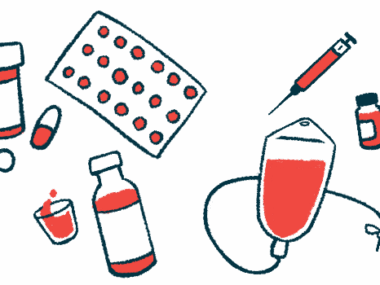Children with CF found to benefit from long-term Trikafta treatment
Extension study reports improved lung function, fewer respiratory symptoms
Written by |

Long-term Trikafta treatment led to improved lung function, fewer respiratory symptoms, and lower sweat chloride levels — elevated levels are a key hallmark of cystic fibrosis (CF) — in children with CF, ages 6 to 11, according to new findings from a two-year extension study.
Trikafta was generally well tolerated, with a safety profile consistent with that of the parent clinical trial and among patients in older age groups, the data showed.
“These results confirm the favorable safety profile and durable clinical benefits of [Trikafta] in this pediatric population,’’ the researchers wrote.
The new data were detailed in “Elexacaftor/tezacaftor/ivacaftor in children aged ≥6 years with cystic fibrosis heterozygous for F508del and a minimal function mutation: Results from a 96-week open-label extension study,” which was published in the European Respiratory Journal. The work was sponsored by Vertex Pharmaceuticals, which markets Trikafta; four of the 12 authors are employed by Vertex, while the other eight have received grants and other support from the company.
Trikafta targets common genetic mutation seen in CF children
Mutations that cause CF impair the function or production of CFTR, a protein that normally helps control the flow of water and salts into and out of cells. Without working CFTR, thick, sticky mucus builds up in various tissues and organs, especially the lungs and digestive tract. F508del is the most common among the more than 2,500 CF-causing mutations, and is found in about 90% of patients.
Trikafta is a CFTR modulator therapy that contains three active ingredients designed to boost the production and function of CFTR in people with certain disease-causing mutations. It’s approved in many countries to treat CF patients as young as 2 years who carry at least one copy of the F508del mutation.
The short-term benefits of Trikafta in school-age children with CF, ages 6-11, were demonstrated in a Phase 3b clinical trial (NCT04353817). All patients carried one copy of the F508del mutation and one minimal function mutation that results in a CFTR protein with limited function. Participants were randomly assigned to Trikafta or a placebo for 24 weeks.
Final data showed that Trikafta improved lung function, reduced respiratory symptoms, and lowered sweat chloride levels, a sign of a more active CFTR protein.
These results suggest that [Trikafta] leads to rapid and durable improvements in CFTR function in children with CF.
Of the children who completed the 24-week parent trial, 120 enrolled in an open-label extension study (NCT04545515, EudraCT, 2020-001404-42), in which all received Trikafta for an additional 96 weeks, or nearly two years.
Data showed that the mean sweat chloride levels in children who transitioned from the placebo in the parent study to Trikafta in the extension study dropped by 57.3 millimoles per liter (mmol/L) after 96 weeks. Children who continued with Trikafta in the extension study saw a 57.5 mmol/L mean reduction in sweat chloride levels by the end of 96 weeks versus the beginning of the parent study, which serves as the baseline.
“These results suggest that [Trikafta] leads to rapid and durable improvements in CFTR function in children with CF,” the team wrote.
Lung function seen to improve by over 6% in all children in study
Lung function, as assessed by forced expiratory volume in 1 second, a standard measure used in CF, was found to improve by 6.1% among children who transitioned from the placebo to Trikafta. Similarly, it improved by 6.9% compared with baseline, or from the study’s start, in patients who were treated with Trikafta all along.
The researchers also examined the effect of treatment on the lung clearance index, known as LCI. Measures of LCI, the scientists wrote, “can provide a more sensitive means to detect early changes in lung function and are considered an appropriate efficacy measurement for younger children with airway diseases.”
At 96 weeks, the mean LCI score decreased — meaning improvements were seen — by 1.74 units for patients who transitioned from the placebo to Trikafta and by 2.35 units for those who continued with Trikafta.
In comparison, children with CF who were not treated with a CFTR modulator in a natural history study showed an annual increase of 0.29 LCI units, the team said.
Trikafta also significantly eased self-reported respiratory symptoms, as indicated by a child’s version of the Cystic Fibrosis Questionnaire-Revised (CFQ-R). Mean scores improved by 6.6 points for children who started Trikafta in the extension study and by 2.6 points for those who continued treatment from the baseline study.
“These results demonstrate that [Trikafta] leads to durable improvements in lung function and respiratory symptoms in children with CF,” the researchers wrote.
Nearly all children (98.3%) experienced adverse events (AEs), most of which were mild (43.3%) or moderate (48.3%) in severity. The most common AEs affecting at least 20% of children were COVID-19, seen in 58.3% of patients, and cough, experienced by 51.7%. The common cold was seen in 45%, fever in 40%, headache in 37.5%, and upper respiratory tract infections in 30.8%. Other side affects were sore throat, nasal inflammation, abdominal pain, and vomiting, all seen in 20% or more of the patients.
“[Trikafta] was generally safe and well-tolerated for up to 96 weeks of treatment in children 6 years and older, with a safety profile generally consistent with the established safety profile of [Trikafta],” the researchers wrote.








